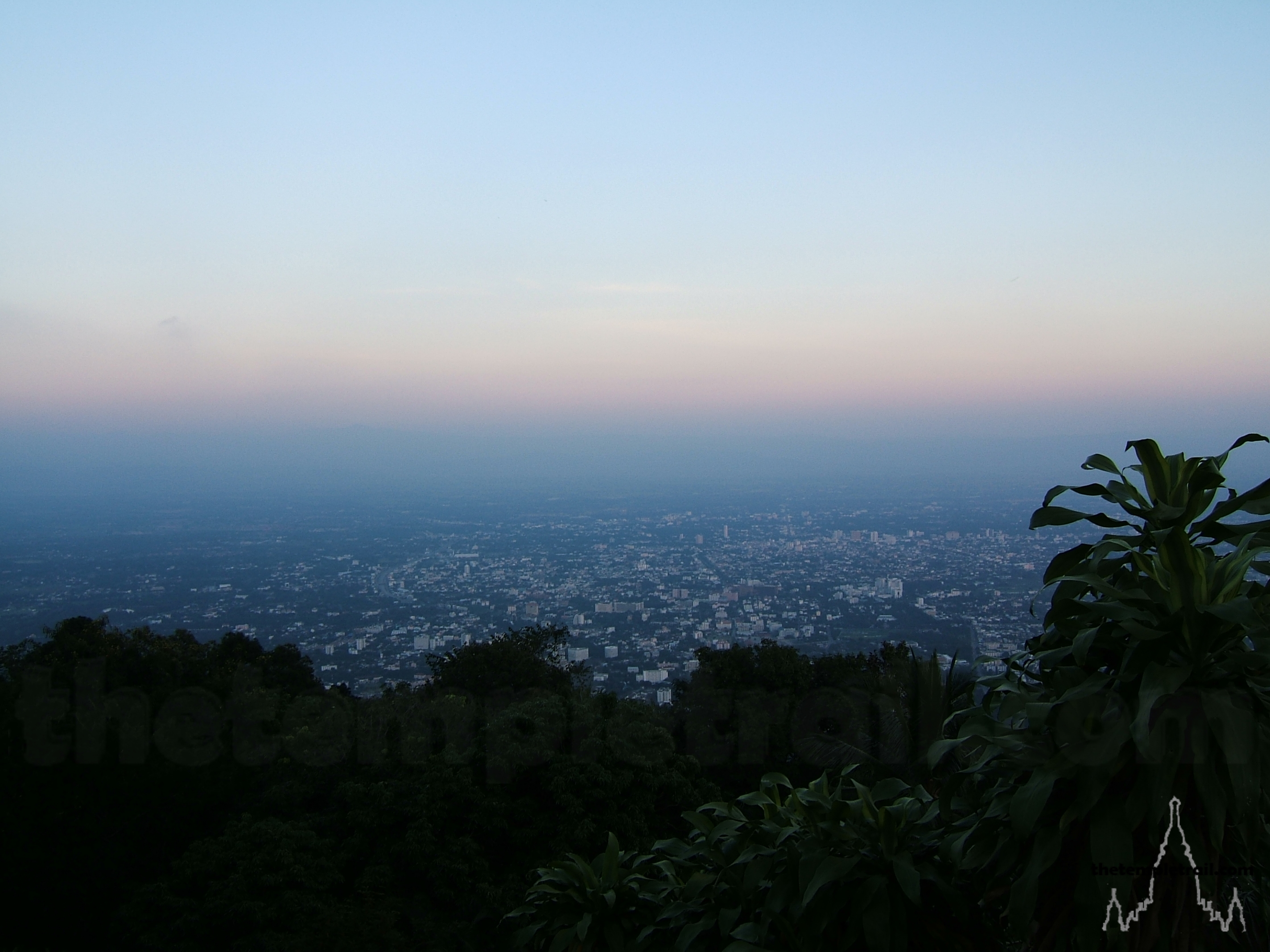The taxi driver understood your request and is happy that he knows where to go. You cut in and out of traffic as the car negotiates its way around West Lake in Hangzhou. The drive takes you through tea plantations and businesses selling the famous Long Jing tea. You feel like you have left the city as the buildings give way to forest. A cool atmosphere relaxes your body and the urban heat seems a million miles away. The taxi driver drops you off and you walk towards a ticket station. You hand over your yuan, walk through the turnstile and over the bridge where you are confronted with a group of Chinese tourists posing in front of something. The crowd clears and an ancient stone vision appears. A Buddha carved into the bare rock hundreds of years ago. Next to it is a worn and weathered stone pagoda, called Elder Li’s Pagoda (理公塔 Lǐ Gōng Tǎ), that houses the ashes of Huili (慧理 Huìlǐ), founder of Lingyin Temple (靈隱寺 Língyǐn Sì). You have arrived at the Feilai Feng grottoes (飛來峰 Fēilái Fēng), the gateway to one of the richest and most established Buddhist temples in China. The sign on the preceding gate reads “The Western Heaven is within reach” (咫尺西天 zhǐchǐ Xītiān) and beyond it is Língyǐn Sì, the Temple of the Soul’s Retreat.
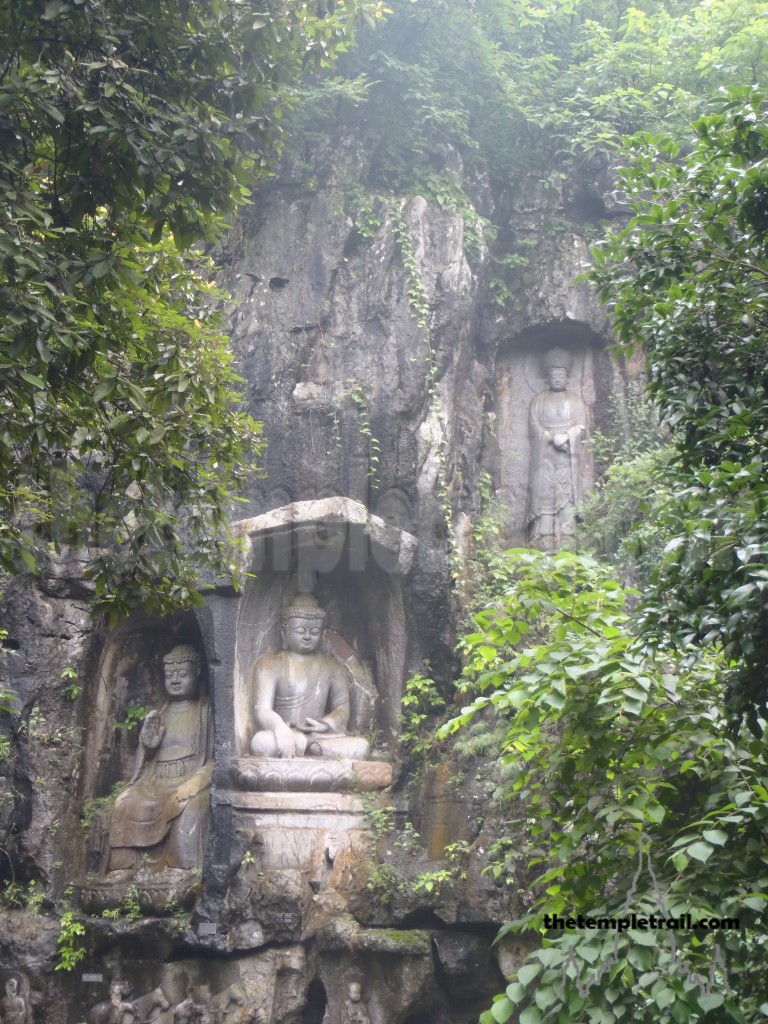
The grottoes of Feilai Feng, the “peak that flew hither” are breath-taking. They don’t have the grandeur of other similar sites around China, but they have a simple beauty that shines through the hordes of eager home-grown visitors. Numerous Buddhas look down on you as you make your way along the well-worn path to Lingyin. The story of Sūn Wùkōng (孫悟空), the monkey king and his journey to the west is etched below a large Buddha carved into the rock. This homage to the characters from the famous Ming dynasty (1368 – 1644 CE) novel Journey to the West (西遊記 Xīyóujì) is fitting, as Wú Chéng’ēn (吳承恩) wrote the book in Hangzou in the 16th century. Going through an opening under yet another Buddha image, you enter the caves. Walking through caverns, you pass an almost invisible carving on Guānyīn (觀音), the Goddess of Mercy, lit up by a single shaft of light that penetrates the darkness of the chamber. The chamber opens up to the ethereal river that you once had to cross using stepping stones that are now out of bounds. Here the mist shrouded water transports you to an impossibly mystical land.
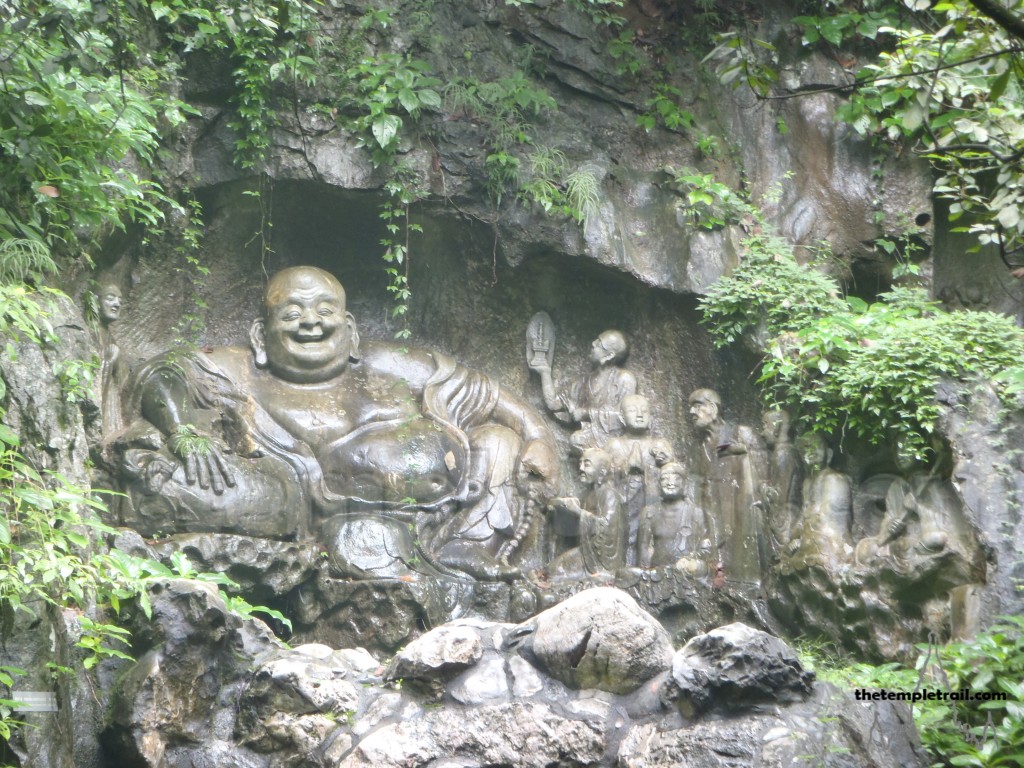
The path takes you by a beaming Sack Cloth Monk (布袋 Bùdài), the fat figure so often confused for the Buddha in the west, as well as a fantastic carving of Mañjuśrī (文殊 Wénshū), one of the most important bodhisattvas in Chinese Buddhism. More and more precariously positioned carvings greet you on your way, before you eventually come to the main temple. Lingyin Temple was founded by an Indian monk, known as Huili by the Chinese, in 328 CE, but has been rebuilt numerous times since then. The buildings that you see today are mostly from the 19th, 20th and 21st century, but they certainly stand up to the weight of history that sits on their shoulders. As you walk up through the temple, you go straight up to the last buildings from the right-hand side, rather than fighting your way through the crowds gathered in the central part of the temple complex. You come first to a fantastic censer (香爐 xiānglú) supported by demons and dragon columns that stands before the shrine of Ji Gong (濟公 Jì Gōng). The brazier looks as though it is the very bowels of Hell itself as the smoke billows out and across the doorway. The mad monk Ji Gong, also known as Dao Ji (道濟禪師 Dàojì Chánshī) was a monk of the temple who was expelled for eating dog meat and drinking alcohol. He subsequently wandered the town helping people and getting drunk. He was given a bodhisattva status after his death at nearby Jingci Temple, where he had risen to become the abbot. The unconventional figure is very popular with Chinese people, as they feel they can relate to him. His image can be found in Buddhist and temples around the Chinese diaspora. His laughing statue at Lingyin Temple looks out of his shrine at you and you smile back at the rascal.
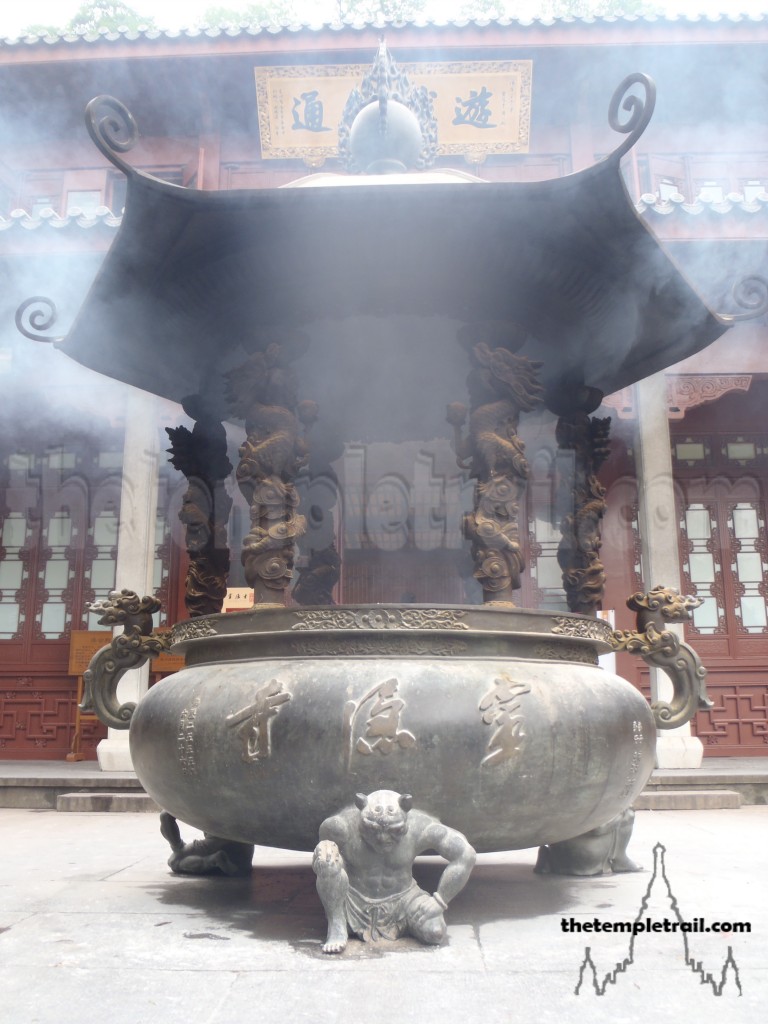
From here you go to the last hall of the central axis and you find the monks are chanting in front of a massive Buddha statue. This is the Hall of the Medicine Buddha (藥師殿 Yàoshī Diàn) houses a huge statue of Bhaiṣajyaguru (藥師佛 Yàoshīfó), the Medicine Buddha and many come here to be healed of their ills. The Medicine Buddha is a celestial Buddha who resides in the Eastern Pure Land and cures the sick. You begin to track your way back down the middle section of the temple grounds through incense and devotees. You come next to the northern end of the Grand Hall of the Great Sage (大雄寶殿 Dàxióng Bǎodiàn). You are greeted by a towering statue of Guānyīn against a spectacular relief screen . The laminated wooden screen is vast and Guānyīn standing above a makara water monster is surrounded by a hundred and fifty arhats (羅漢 luóhàn), scores of enlightened beings and Sūn Wùkōng accompanied by his fellow pilgrims to India. The joss-stick smoke is thick, the air chokes your lungs and the scent burns your nostrils. In front of the screen is the main Buddha image of the temple. It is a vast camphor wood statue of Śakyamuni (释迦牟尼 Shìjiāmóuní), the historical Buddha. Carved in the mid-1950s and coated in gold the sublimely-crafted statue is the largest wooden Buddha statue in China. It’s imposing presence in the hall takes you aback. Standing in awe for several minutes, you take in the grand vision in silence.
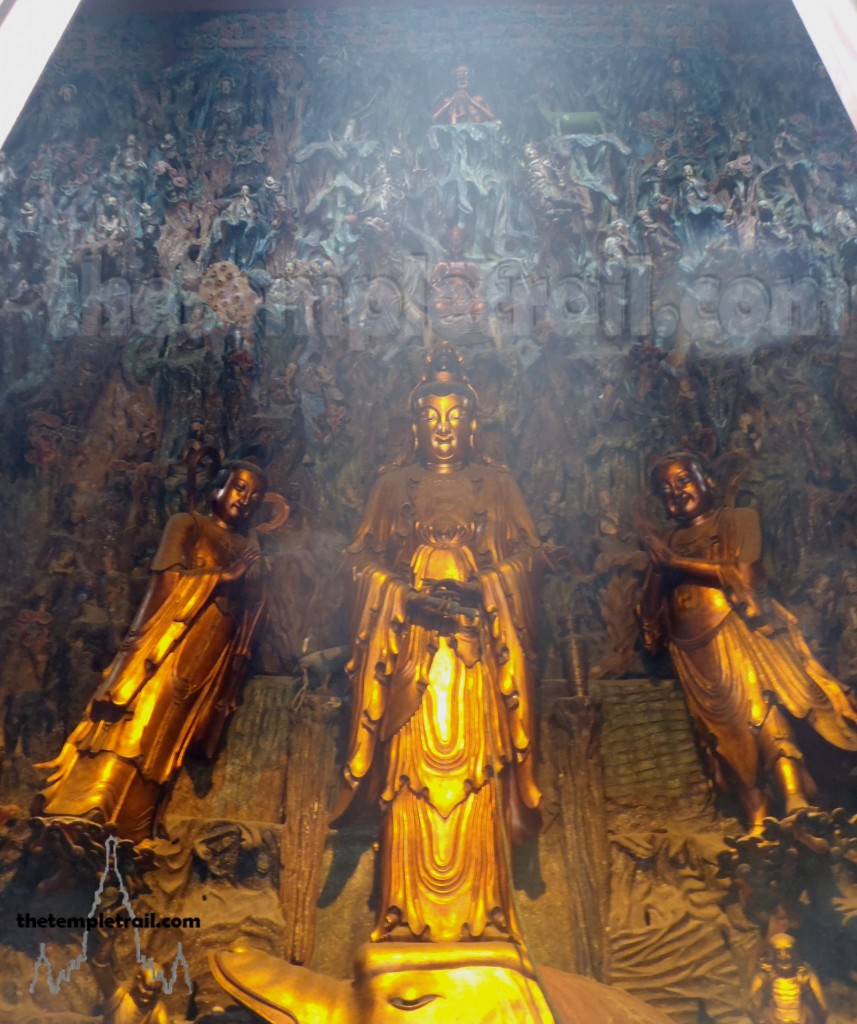
Walking out of The Grand Hall, you come to a part of the temple that contains imposing, ancient statues: The Hall of the Heavenly Kings (天王殿 Tiānwáng Diàn). Before the days of turnstile gates and LED signs, this was the first hall of the temple. Normally, the Hall of the Heavenly Kings comes after the entrance gate on the central south-north axis, but here, there is no entrance gate. The modern entrance is to the side of the hall, and the chamber’s front gate is bolted shut. Pilgrims would have paid homage to the Four Great Heavenly Kings (四大天王 Sì Dà Tiānwáng) before obtaining an audience with Buddha. The four directional kings of north, south, east and west grimace down at you with their gigantic visages and remind you that you are being watched by potent heavenly forces. The hall has a statue of Bùdài laughing at the now closed southern door. His fat belly and expansive grin would have been the first figure that visitors met upon their entry to Lingyin. On the other side, facing the temple interior is the oldest statue in the temple. It is of Skanda (韋馱 Wéituó), the protector of the sutras. The martial bodhisattva’s statue is800 years old and dates to the Southern Song dynasty (1127 – 1279 CE). The Song dynasty ruled China from 960 to 1279, but were pushed out of their northern territories by the Jin in 1127. They relocated their capital city from Kaifeng in Henan province, to Hangzhou, which they held until the Mongols of Kublai Khan (元世祖 Yuán Shìzǔ) swept through their lands in 1279.
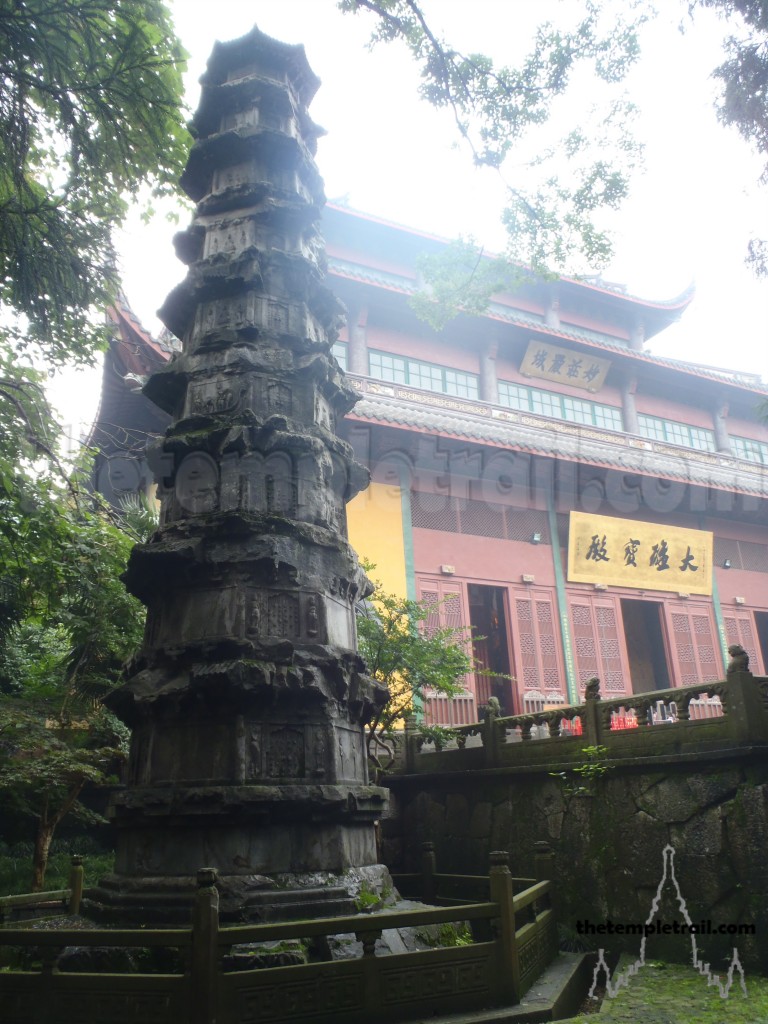
There is one last building to visit before leaving the temple grounds: The Hall of the Five Hundred Arhats (五百羅漢堂 Wǔbǎi Luóhàn Táng). The hall is a very unusual swastika-shaped modern annex to the temple. Walking the course of the building, you pass by 500 larger than life bronze statues of the arhats with their long eyebrows and strange shaped heads. By doing the walk you are performing a walking meditation in the form of a swastika, a sacred Buddhist symbol. The statues line both sides of the path and as you walk, you pass all of them. The centre of the building holds the tallest solid bronze structure in the world: a shrine housing four directional bodhisattva statues. It is a striking centrepiece and commands the middle of this unique, engaging building. You leave the temple and head out to the other two places of interest in the area. The ticket to Feilai Feng also grants you access to two other temples, Yongfu Temple (永福寺 Yǒngfú Sì) and Taoguang Temple (韜光寺 Tāoguāng Sì). Yongfu has a wonderful statue of the Buddha in the Hall of the Three Heroes, but the real gem is the almost deserted Taoguang Temple. You need to be prepared for a moderately challenging uphill climb; the main reason that it is so empty. The carrot at the end of your trek is the view across the mountains and the misty forest from the top pavilion. The view is one of the famous eighteen scenes of the West Lake of the Qing dynasty (1644 – 1912) called “viewing the sea from Taoguang temple” (韜光觀海Tāoguāng guān hǎi).
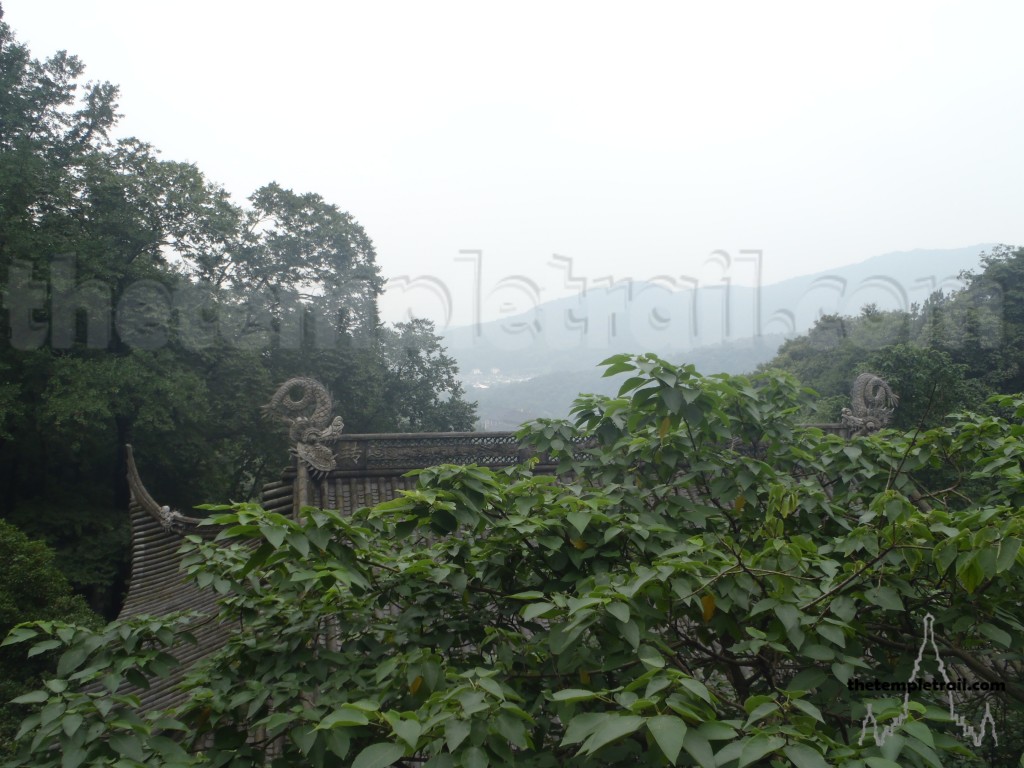
As you gaze out from the peak of the Lingyin-Feilai Feng Scenic Area, you feel that you have transcended. You have left the grey, lifeless structures of modern Hangzhou and have climbed the mountain of tranquillity. Your lungs fill with fresh air and your body feels revived and refreshed. The crystal mountain air replaces the exhaust fumes and even the faint trace of joss-stick smoke that trails from a brazier doesn’t disturb the purity of the air. Once more you can take on the modern world, having dipped briefly back into the spirituality of bygone times and allowed the western heaven to penetrate your city living toughened psyche.
To find out more and to plan your visit, the Lingyinsi website has plenty of information.
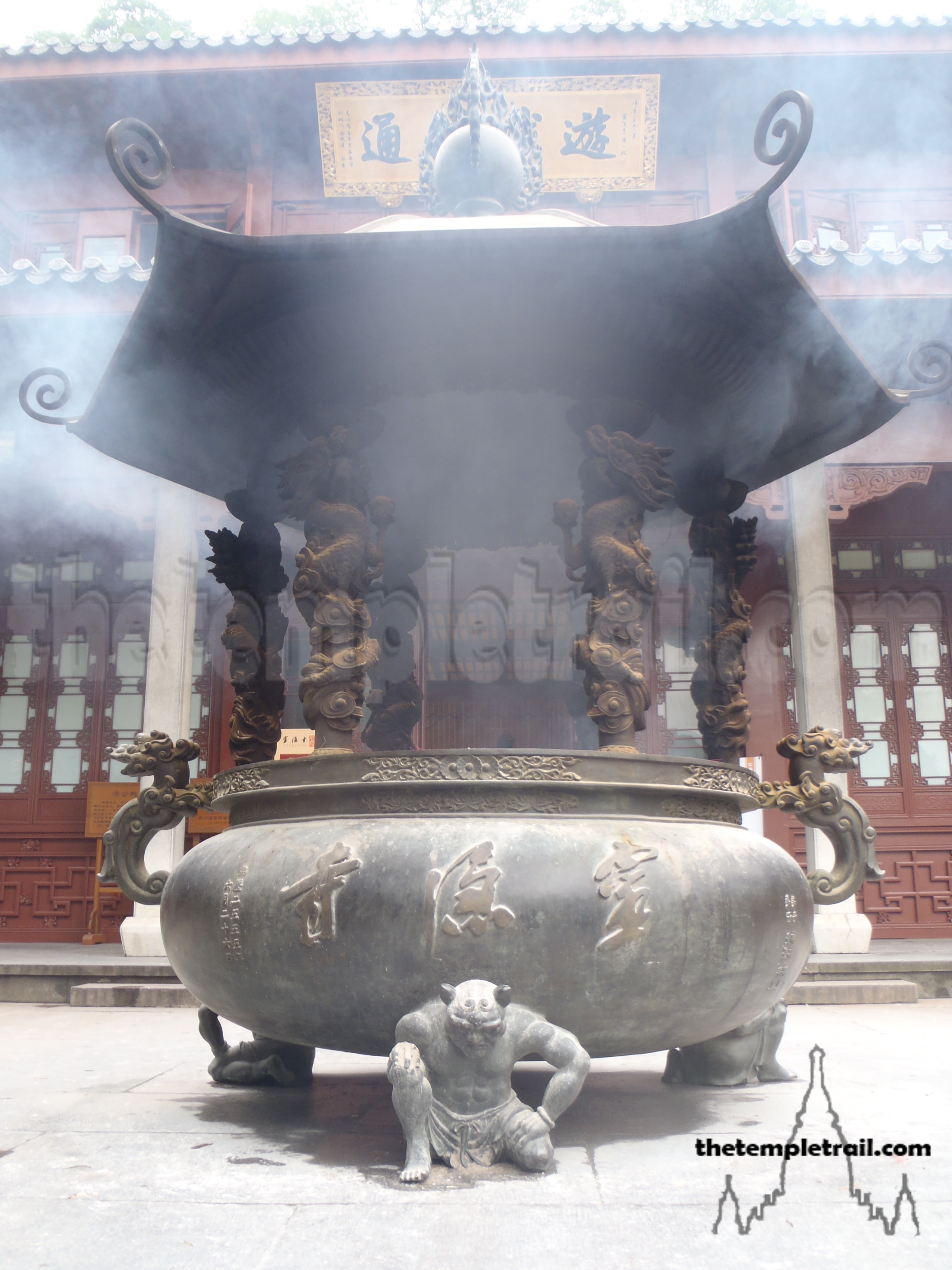
 Candi Sukuh
Candi Sukuh